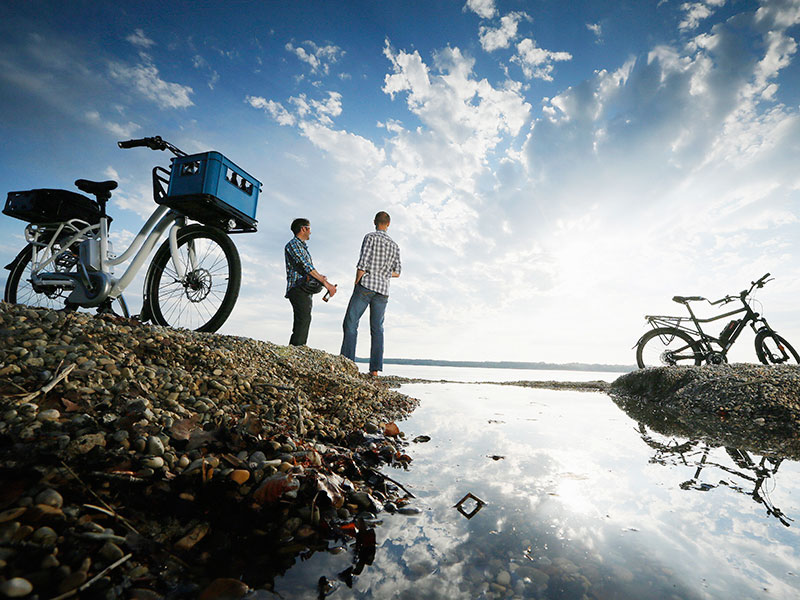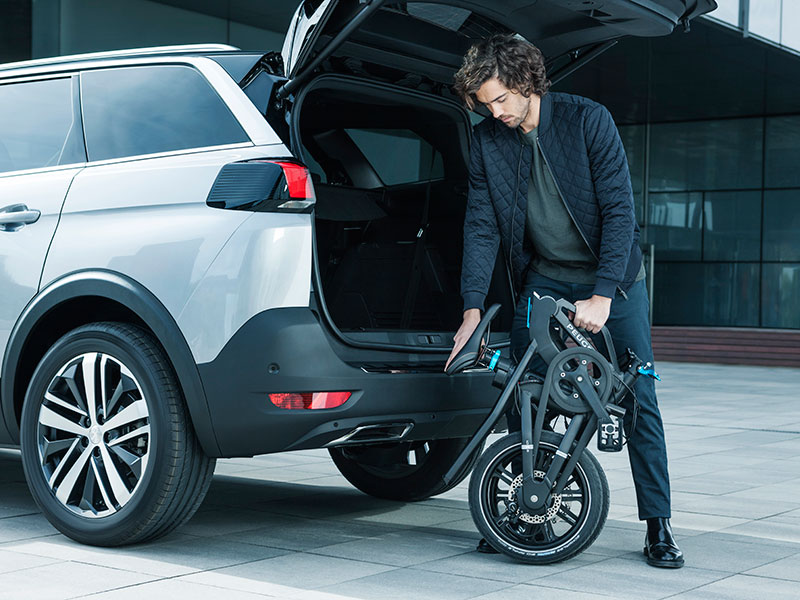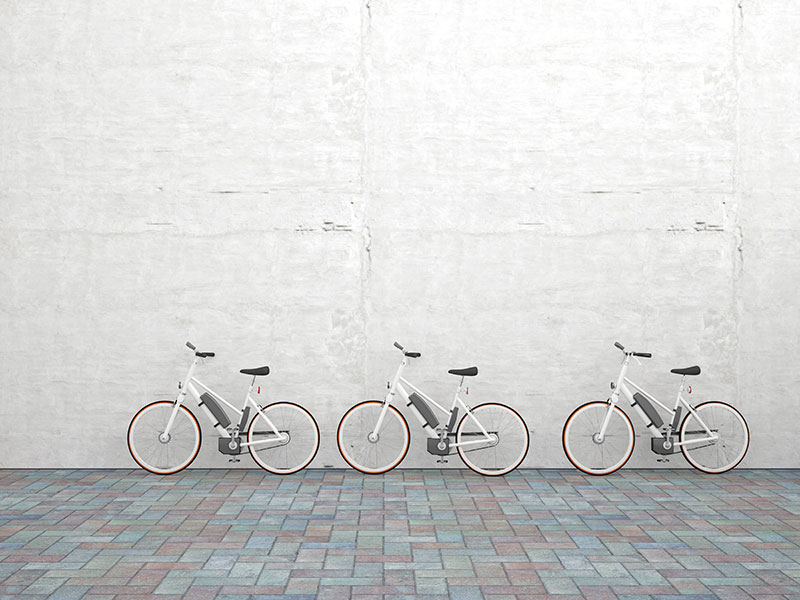
At the Geneva Motor Show in January 2017, surrounded by the latest models in the car market, a bicycle became one of the most talked-about vehicles at the event. The attention was justified: the bicycle, which was designed by Bugatti and developed by German bicycle firm PG, combines the best of the sport and aeronautic industries in a carbon frame that weighs less than 5kg.
Prices start at $39,000 (€33,000), while the individually tailored version costs as much as $69,000 (€58,700). One of these customised bicycles can be more expensive than a BMW 4 Series, a top seller in the luxury car segment, which retails at around €36,000.
The exclusive Bugatti bike is not meant for the masses; if the price tag isn’t enough to make that clear, the brand has said only 667 units will be produced. Bugatti and PG’s bicycle is an example of the increasing sophistication in the high-end segment. Beyond this unique product, the current demand for premium bicycles is being met by the latest models of e-bikes.
Luxury biking
The search for solutions to urban traffic and pollution, plus rising awareness about healthy lifestyles, has boosted the use of bicycles in urban environments. As such, all segments of the market, including the high end, have grown.
Luxury is closely linked to convenience, and the ability to avoid rush hour and packed public transport is perhaps one of the biggest benefits of bicycle travel. At a time when European cities are incentivising cycling by improving their infrastructure for bikes, commuting on two wheels is easier than ever.
Luxury is closely linked to convenience, and the ability to avoid rush hour and packed
public transport is perhaps one of the biggest benefits of travelling by bicycle
Incentives to cycle are coming from bicycle makers as well. With the aim of transforming the daily commute by making the journey faster as well as easier, most of the novel offerings in luxury bicycles have been battery-powered. The products emerging from this focus are light, foldable and stylish.
An e-bike is halfway between a traditional bicycle and a motorbike. Specifically, it is defined by its integrated electric motor, battery and control system. This mechanism provides an electric boost to the rider’s pedalling, making it easy to reach speeds of around 20km/h without breaking a sweat.
“Electric bicycles are the number one selling electric vehicle in the world,” said Ryan Citron, Research Analyst at Navigant Research, a consultancy firm that caters to global clean technology markets. With this position, and a total of 35 million global sales in 2016, the success of e-bikes is no surprise.
Today, state-of-the-art urban cycling is a mixture of developments that have proved popular with the public: foldable models and electric support. The latter makes the luxury bicycle market an obvious opportunity for carmakers, which can apply their expertise in engines to developing bicycles.
Collaborative development
The reinvention of the traditional two-wheeled vehicle has given birth to models that are both technologically advanced and on trend. This is certainly the case for Peugeot’s latest creation: the company’s design lab unveiled its first folding electric bicycle in 2016, and launched it into the market in the first half of 2017.
The eF01 is a step forward for Peugeot, which has been a long-standing player in the bicycle sector since 1892, when it designed a folding bike for the French army. In the era of e-bikes, the eF01 is a blueprint for a new generation of electric folding bikes.
Peugeot’s newest bike targets “customers looking for mobility solutions to complement their vehicle”, according to the company. It described the bike as a “last kilometre” mobility product, because it’s “perfect for travelling the last few kilometres in the city after parking the car”.
As such, the e-bike matches perfectly with the firm’s range of cars, as it can be stored and recharged in the dock station within the boot of Peugeot’s 5008 SUV, which was launched alongside the eF01, or any vehicle with a 12v outlet. In only two hours, the bike’s battery is ready to ride distances of up to 30km at 20km/h. Furthermore, users can check the bike’s battery by connecting the bicycle to a smartphone via Bluetooth.
In the same vein is Brompton’s first electric bike, which is expected to break ground in early 2018. The British fold-up bike maker is already taking orders for its most recent model, the conception of which involved a collaboration with Formula 1 group Williams Martini Racing.
The reinvention of the traditional two-wheeled vehicle has given birth to
models that are both technologically advanced and on trend
“We’ve spent three years taking Williams Racing technology and integrating it into the Brompton. It has been harder than any of us imagined, but we believe we have created a product that will inspire more people to get out from under the ground, out of their cars and back onto a bike to rediscover their cities,” said Brompton’s CEO, Will Butler-Adams, at the bike’s launch.
The newest iteration of the folding bike has a removable lithium-ion battery, which reduces the risk of theft. With electrically-assisted pedalling, the bike is capable of reaching a maximum speed of 24km/h. All of these improvements, together with a handful of connection tools that allow riders to track their mileage, are leading Brompton to set a higher standard in the industry.
Brompton’s folding electric bike costs between £2,595 (€2,927) and £2,755 (€3,107), and for UK residents who can’t wait until its release, reservations can be placed for £200 (€225). The total price is several times higher than the basic model of non-electric Bromptons, which are on sale from £840 (€947), but as the price has increased, so have the product’s advantages.
Butler-Adams believes the product will help the company double the size of its business in the next three to five years. Speaking to European CEO, he measured the potential for the brand: “The electric bike market has grown hugely in Germany, the Netherlands and France, with other European countries following suit.
“The number of e-bikes sold in the UK is considerably lower than some of its other European counterparts, estimated at around 50,000 in 2016. However, this was 20 percent up on the previous year, showing the potential growth for e-bikes in the UK.” In London, only five percent of all journeys are made by bike, compared with 13 percent in Berlin and more than 50 percent in Copenhagen, according to Brompton’s estimates.
In the longer term, Butler-Adams believes there will be more bikes on the streets, and today’s innovation will become the new normal. As he said in an interview with the Financial Times: “My feeling is, in the long term in cities, normal bikes will disappear”.

Perfectly balanced
To attract high-end consumers, industry players must place as much importance on style and design as technology. The partnership between bicycle maker Diavelo, a Dutch company that is part of Accell Group, and Italian transport design studio Pininfarina, which designs for Ferrari, does just this.
Accell is one of the largest bicycle producers in the world. Its home market is the second largest in electric bike production in the EU, behind Germany, but the leader in prices. On average, Dutch customers pay €1,010 per bike, far above the €700 average spend in Denmark, which is the second-largest market in prices, according to the Confederation of the European Bicycle Industry.
Meanwhile, Italy was the first traditional bicycle producer in the EU in terms of volume, which comes alongside a long tradition of manufacturing exquisite luxury cars. The Diavelo Pininfarina deal resulted in E-voluzione, a dazzling family of high-end electric bikes.
Paolo Pininfarina, the group’s chairman, explained the company’s goal: “We have always been sensitive to the environmental sustainability issues: e-bikes are a strategic means of transportation for smart cities of the future and we wish to be present in the sector with our E-voluzione project.”
To attract high-end consumers, industry players must place as much importance on style and design as technology
The first sample of E-voluzione was launched in 2016. Since then, the bicycle has received international recognition for its design and functionality. “The E-voluzione bike has a best-in-class performance: it is light and comfortable, and it represents the optimal integration of several components such as frame, motor, transmission, battery and brakes,” Pininfarina explained.
This €6,300 bicycle has a German motor embedded in the carbon frame and a removable battery. The whole bike weighs just 16kg, far below the average for such a product. More recently, the Pininfarina Diavelo collaboration released a limited edition version of E-voluzione: Elettronica. Elettronica is distinguished from its predecessor by its carbon frame, electronic gears and integrated GPS. The newest design will be on sale from January 2018, at €10,000, for only 88 customers.
Raising the bar
The latest developments in the bicycle industry have raised standards higher than ever, yet other visionaries are willing to push the sector even further. Swiss innovation and design firm Voltitude is one of them. The company is determined to develop a luxury folding e-bike of unprecedented quality. According to its ethos, Voltitude “fuses the art of Swiss precision watchmaking with leading age electronic drive and smart connectivity technologies”.
To make this a reality, the firm struck a deal with Formula E driver Jérôme d’Ambrosio and globally recognised French designer Mathieu Lehanneur, whose work is on display at the Museum of Modern Art in New York and the Centre Pompidou in Paris, among others.
After two years of intense R&D, Voltitude is set to unveil its flagship product in 2018. Executive Manager Valentin Guyonnet addressed the opportunity: “Because luxury cars are less and less relevant in city centres, [the] time has come to offer alternative mobility products that can rival cars when it comes to exclusivity, status, luxury, convenience and fun. We want to offer the
cool factor as a bonus.”
According to data collected by Navigant Research, the European electric bicycle market reached a total of 1.6 million units in 2016, and is expected to double by 2025. “The emerging luxury segment is growing and remains unexploited,” Guyonnet said. “No competitor combines the revolutionary design attributes of Voltitude with such an effortless folding system.”
The company wants to reach clients by avoiding traditional bicycle retail channels. The plan is to position its bikes through deals with luxury hotels, international resorts and other exclusive partners, such as a private racing driver clubs. “The strategy targets the HENRY (high earners, not rich yet) segment, whose annual income ranges from $100,000 [€85,000] to $250,000 [€213,000], and are 75 percent men aged between 25 and 35 years-old, geo-located in densely populated cities,” Guyonnet explained. Along with this portion of consumers, Voltitude will try to attract higher earners keen to own well-designed, unique and rare products.

21st-century travel
The groundbreaking technological developments that have transformed the luxury bicycle market are the just tip of the iceberg. Citron identified different forces pushing the bicycle industry’s expansion and upgrade: “Urbanisation and city life are certainly big drivers, which go along with improvements in bicycle infrastructure.
“There’s an increasing… population, and people are looking for alternatives to avoid getting stuck in traffic jams and paying for expensive car parking and gas,” he said.
Europe has several examples of countries committed to developing strong bicycle infrastructure in order to encourage people to cycle. “City planners are favouring cycling also as part of policies towards decreasing energy consumption,” he added.
Germany is at the forefront of bike infrastructure, particularly with regards to the creation of its highway for bicycles. Construction started in 2015 and aims to connect 10 cities – including four universities – over 100km in the north-west of the country. The estimate is that, once complete, the new infrastructure will remove 50,000 cars from the roads and thousands of tonnes of CO2 emissions daily.
Germany has one of the most evolved electric bicycle markets in the world; with a total of 600,000 sales in 2016, only China outpaced it. In Europe, its 36 percent market share is more than double that of the Netherlands, which is the second-largest market in size. As such, the bicycle industry is providing incentives for social change by offering an enriched and varied portfolio.
There’s even more to see in terms of sophistication, Citron said: “We see prices decreasing over time, as the prices of batteries are coming down. This is significant because batteries represent 30 percent of the cost of an electric bike.” The fall in price gives more room for e-bikes to increase their reach, but also for developers to add new technology tools to their products. “There will be more digital integration between bicycles and phones, which is part of the nature of these bikes,” Citron said.
Increasing consumer awareness is turning the reinvented bicycle into the natural replacement for traditional models. With forecasts and estimates already predicting e-bikes’ huge potential, they are set to revolutionise 21st-century travel.

